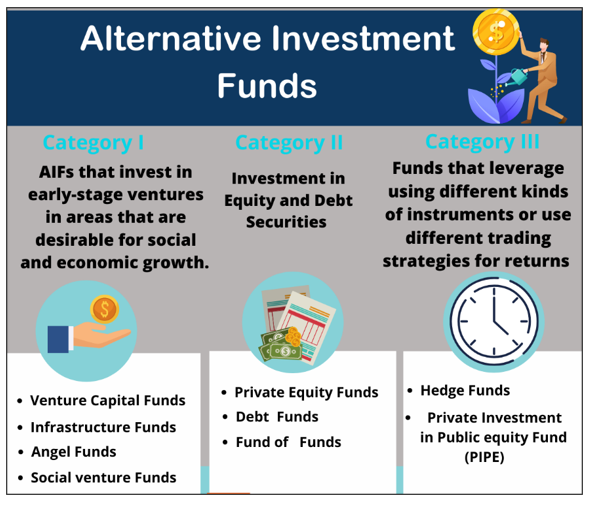SYLLABUS
GS-3: Indian Economy and issues relating to planning, mobilization, of resources, growth, development and employment.
Context:
Recently, the Reserve Bank of India (RBI) has issued the RBI (Investment in Alternative Investment Funds) Directions, 2025, to regulate and streamline investments made by Regulated Entities (REs) in Alternative Investment Funds (AIFs).
More on the News
REs refer to banks, NBFCs and All-India Financial Institutions.
These rules limit how much banks and NBFCs can invest in Alternative Investment Funds.
A single entity can only contribute up to 10 percent of an AIF scheme. All regulated entities together cannot exceed 20 percent. RBI may exempt certain AIFs from these rules after consulting with the government.
- In a draft circular issued in May 2025, the RBI had proposed a lower cap of 15%, but the final guidelines have revised it to 20%.
The new directions RBI (Investment in Alternative Investment Funds) Directions, 2025 will come into effect on 1 January 2026, or from any earlier date as decided by an RE.
These Directions shall be applicable to investments by the following REs in units of AIF Schemes:
- Commercial Banks (including Small Finance Banks, Local Area Banks and Regional Rural Banks)
- Primary (Urban) Co-operative Banks/ State Co-operative Banks/ Central Co-operative Banks
- All-India Financial Institutions
- Non-Banking Financial Companies (including Housing Finance Companies)
Limits on Investments and Provisioning
- No RE shall individually contribute more than 10 per cent of the corpus of an AIF Scheme.
- Collective contribution by all REs in any AIF Scheme shall not be more than 20 per cent of the corpus of that scheme.
- Suppose a RE contributes more than 5% of the corpus of an AIF Scheme, which also has downstream investment (excluding equity instruments) in a debtor company of the RE.
- In that case, the RE shall be required to make 100 per cent provision to the extent of its proportionate investment in the debtor company through the AIF Scheme, subject to a maximum of the direct loan and/ or investment exposure of the RE to the debtor company.
- Notwithstanding the above-mentioned provision, if a RE’s contribution is in the form of subordinated units, then it shall deduct the entire investment from its capital funds – proportionately from both Tier-1 and Tier-2 capital (wherever applicable).
Key definition
- ‘Debtor company’ of the RE shall imply any company to which the RE currently has or previously had a loan or investment exposure (excluding equity instruments) anytime during the preceding 12 months.
- ‘Equity instrument’ shall refer to equity shares, compulsorily convertible preference shares (CCPS) and compulsorily convertible debentures (CCD).
Alternative Investment Fund
AIF is any fund established or incorporated in India which is a privately pooled investment vehicle which collects funds from sophisticated investors, whether Indian or foreign, for investing it in accordance with a defined investment policy for the benefit of its investors.

They are governed by the SEBI (Alternative Investment Funds) Regulations, 2012, and are distinct from other categories of pooled investment vehicles regulated by SEBI.
An AIF can be set up as a trust, a company, a limited liability partnership, or a corporate body.
AIFs do not include the following:
- Mutual Funds regulated under the SEBI (Mutual Funds) Regulations, 1996.
- Collective Investment Schemes (CIS) governed by the SEBI (Collective Investment Schemes) Regulations, 1999.
- Any other fund that is governed by separate regulations framed by SEBI for the purpose of pooling of capital.



